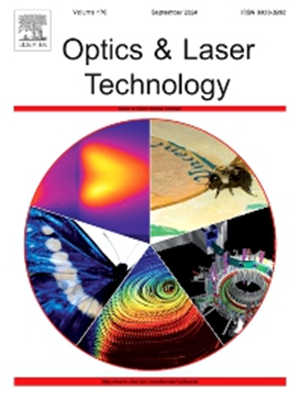通过激光烧蚀在液态和沸腾氧化铝中扩散氢气,实现无碳铝生产
IF 5
2区 物理与天体物理
Q1 OPTICS
引用次数: 0
摘要
霍尔-赫鲁特工艺是铝的主要生产工艺,它消耗碳电极将氧化铝(Al2O3)还原成铝,同时释放出副产品二氧化碳(CO2)。为了克服这一问题,实现绿色转型,有人提出了激光还原 Al2O3 这种无碳铝生产方法。通过将连续波激光照射到 Al2O3 表面,在其表面析出微小的铝颗粒。此外,使用氢气作为环境气体后,表面下方出现了气孔,其中还含有铝颗粒。本研究探讨了通过氢气扩散形成的内部孔隙结构与激光辐照 Al2O3 产生铝之间的相关性。在激光辐照过程中,通过旋转 Al2O3 靶件,孔隙结构的体积进一步增大。在 0.9 巴的氢气环境中,研究了氢的扩散取决于激光通量及其对孔隙形成的影响。直径为 20 毫米的靶的旋转速度在每分钟 2 转和 4 转之间变化。激光功率恒定为 1.5 千瓦,光斑半径为 1.22 毫米至 3 毫米。结果表明,在其他条件相同的情况下,从氩气环境改为氢气环境,孔隙体积成功增加了 20 倍。通过扫描电子显微镜(SEM)验证了孔隙中铝颗粒的丰度。孔隙内的铝颗粒析出具有方向性,因为铝颗粒只出现在孔隙底部。孔隙中存在铝颗粒的结论是,通过增加孔隙容积可以增加析出颗粒的数量,正如本研究中所做的那样。本文章由计算机程序翻译,如有差异,请以英文原文为准。
Hydrogen diffusion in liquid and boiling alumina by laser ablation towards a carbon-free aluminum production
The Hall-Héroult process is the main production process of aluminum, which consumes carbon electrodes to reduce alumina (Al2O3) to aluminum, while releasing the by-product carbon-dioxide (CO2). To overcome this issue and work towards a green transformation, laser reduction of Al2O3 has been proposed as a carbon-free aluminum production method. By irradiating a continuous-wave laser onto the Al2O3 surface, micro-sized aluminum particles are precipitated on the surface. Furthermore, the use of hydrogen as an ambient gas has shown the appearance of pores beneath to the surface, which furthermore contain aluminum particles. In this study, the correlation between the internal pore structure through hydrogen diffusion and the aluminum production on laser-irradiated Al2O3 is investigated. The pore structure is furthermore maximized in terms of volume by rotating the Al2O3 target during laser irradiation. Using a hydrogen atmosphere at 0.9 bar, the diffusion of hydrogen depending on the laser fluence and its effect on the formation of pores is examined. The rotating speed of a 20 mm diameter target size is varied between 2 rpm and 4 rpm. The laser power is constant at 1.5 kW with a spot radius of 1.22 mm to 3 mm. Results show a successful increase of the pore volume by a factor of 20 considering the change from an argon to a hydrogen atmosphere under otherwise equal conditions. The abundance of Al particles in the pores is validated through scanning electron microscopy (SEM). The aluminum particle precipitation inside of the pores shows a directional behavior, as the particles are exclusively found at the bottom of the pores. The existence of aluminum particles in the pores concludes an increase of precipitated particles by increasing the pore volume as performed in this study.
求助全文
通过发布文献求助,成功后即可免费获取论文全文。
去求助
来源期刊
CiteScore
8.50
自引率
10.00%
发文量
1060
审稿时长
3.4 months
期刊介绍:
Optics & Laser Technology aims to provide a vehicle for the publication of a broad range of high quality research and review papers in those fields of scientific and engineering research appertaining to the development and application of the technology of optics and lasers. Papers describing original work in these areas are submitted to rigorous refereeing prior to acceptance for publication.
The scope of Optics & Laser Technology encompasses, but is not restricted to, the following areas:
•development in all types of lasers
•developments in optoelectronic devices and photonics
•developments in new photonics and optical concepts
•developments in conventional optics, optical instruments and components
•techniques of optical metrology, including interferometry and optical fibre sensors
•LIDAR and other non-contact optical measurement techniques, including optical methods in heat and fluid flow
•applications of lasers to materials processing, optical NDT display (including holography) and optical communication
•research and development in the field of laser safety including studies of hazards resulting from the applications of lasers (laser safety, hazards of laser fume)
•developments in optical computing and optical information processing
•developments in new optical materials
•developments in new optical characterization methods and techniques
•developments in quantum optics
•developments in light assisted micro and nanofabrication methods and techniques
•developments in nanophotonics and biophotonics
•developments in imaging processing and systems

 求助内容:
求助内容: 应助结果提醒方式:
应助结果提醒方式:


